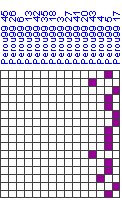| Enriched clinical annotations |
|---|
| For each of the clinical annotations, we tested whether it was enriched in the set of arrays in which the module is significantly induced (or repressed). Below we list all such annotations that were enriched in this module with an FDR corrected p-value of 0.05 ('P-value' column), along with the number ('Hits' column) of induced (or repressed) module's arrays in which they appear. We also show the fraction of the module's induced (or repressed) arrays with the given annotation ('Hits (%)' column). For completeness, we also list the total number of relevant induced arrays in the module ('Module hits in category' column), total number of arrays in the compendium in which the corresponding annotation is present ('Arrays in annotation' column), and the total number of relevant arrays in the compendium ('Arrays' column). Note that the 'relevant' arrays may be different for each annotation, since it includes only arrays in which the annotation was relevant (i.e., present or not present) and excludes arrays where the value of the annotation was not known. Rows that correspond to annotations that were enriched in the induced arrays of the module have a red background, while rows corresponding to annotations enriched in the repressed arrays have a green background. For each annotation, we also list the other modules in which it was enriched. |
| Clinical annotation |
Category |
P-value |
Hits |
Hits(%) |
Module hits in category |
Arrays in annotation |
Arrays |
| B cells (B lymphoma*) |
B lymphoma* |
9.4e-16 |
29 |
59.1 |
49 |
231 |
1945 |
| Lymphocytes (B lymphoma*) |
B lymphoma* |
4.4e-15 |
29 |
59.1 |
49 |
244 |
1945 |
| Chronic lymphocytic leukemia (B lymphoma) |
B lymphoma |
1.7e-14 |
23 |
79.3 |
29 |
46 |
245 |
| Leukemia (B lymphoma) |
B lymphoma |
1.7e-14 |
23 |
79.3 |
29 |
46 |
245 |
| Leukemia or leukemia cell line (B lymphoma) |
B lymphoma |
1.7e-14 |
23 |
79.3 |
29 |
46 |
245 |
| Cancer (B lymphoma*) |
B lymphoma* |
3.3e-12 |
24 |
48.9 |
49 |
200 |
1945 |
| Hematologic cancer (B lymphoma*) |
B lymphoma* |
3.3e-12 |
24 |
48.9 |
49 |
200 |
1945 |
| Cancer and cell line (B lymphoma*) |
B lymphoma* |
1.5e-11 |
24 |
48.9 |
49 |
214 |
1945 |
| Hematologic cancer and cell line (B lymphoma*) |
B lymphoma* |
1.5e-11 |
24 |
48.9 |
49 |
214 |
1945 |
| T cells (B lymphoma) |
B lymphoma |
2.2e-06 |
5 |
41.6 |
12 |
7 |
245 |
| Female hormonal tissue, cancer or cell line (Breast cancer*) |
Breast cancer* |
6.0e-05 |
12 |
26.0 |
46 |
141 |
1945 |
| Breast tissue, cancer or cell line (Breast cancer*) |
Breast cancer* |
6.4e-05 |
12 |
26.0 |
46 |
142 |
1945 |
| Cancer and cell line (Breast cancer*) |
Breast cancer* |
6.9e-05 |
12 |
26.0 |
46 |
143 |
1945 |
| Female hormonal cancer or cell line (Breast cancer*) |
Breast cancer* |
0.0001 |
11 |
23.9 |
46 |
127 |
1945 |
| Breast cancer or cell line (Breast cancer*) |
Breast cancer* |
0.0001 |
11 |
23.9 |
46 |
128 |
1945 |
| Live bacteria stimulated immune cells (Stimulated PBMC) |
Stimulated PBMC |
0.0001 |
3 |
60 |
5 |
5 |
148 |

 >4x
>4x